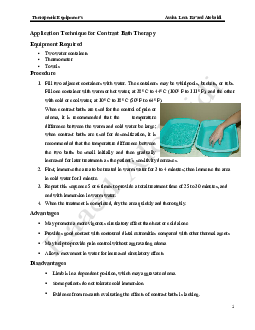

Preview text:
lOMoARcPSD|36041561
Therapeutic Equipment’s Assist. Lect. Ra’aed Alobaidi
Pulsed shortwave diathermy (PSWD)
Has also been used for its non-thermal effects in the treatment of soft-tissue injuries and wounds.
The mechanism of its effectiveness has been theorized to occur at the
cellular level, relating specifically to cell membrane potential.
Damaged cells undergo depolarization, resulting in cell dysfunction that
might include loss of cell division and proliferation and loss of regenerative capabilities.
Pulsed shortwave diathermy has been said to repolarize damaged cells, thus correcting cell dysfunction.
It has also been suggested that sodium tends to accumulate in the cell
because of a decrease in activity of the sodium pump during the
inflammatory process, thus creating a negatively charged environment.
When a magnetic field is induced, the sodium pump is reactivated, thus
allowing the cell to regain normal ionic balance.
pulsed electromagnetic energy (PEME) , pulsed electromagnetic field
(PEMF) , or pulsed electromagnetic energy treatment (PEMET) , is a
relatively new form of diathermy
Application Techniques for Pulsed Shortwave Therapy 1. Parameters
Pulse duration is short, ranging from 20 to 400 sec
Pulse repetition rate, which ranges between 1 and 7000 Hz.
Peak pulse power the amplitude pulse/intensity 100-1000W.
Mean power power delivered from the machine (during pulse and average) Raaed Alobaidi 2. Preparation of the patient 1
Downloaded by Nga T??ng (ngahuong55@gmail.com) lOMoARcPSD|36041561
Therapeutic Equipment’s Assist. Lect. Ra’aed Alobaidi
Evaluate the patient’s problem and determine the goals of treatment.
Confirm that diathermy is the most appropriate intervention. Non-thermal
PSWD can be used where heat is contraindicated or potentially hazardous
and can be applied to insensate patients or to those who cannot tolerate the
sensations associated with other physical agents such as cryotherapy or electrical stimulation.
Determine that diathermy is not contraindicated.
Explain the procedure and the reason for applying diathermy to the patient
and the sensations the patient can expect to feel. The application of non-
thermal PSWD is not generally associated with any change in patient
sensation, although some patients report feeling slight tingling or mild warmth.
Remove all metal jewelry and clothing from the area to be treated.
Clean and dry the skin, and inspect it if necessary.
If applying non-thermal PSWD, it is not necessary to place towels between
the applicator and the body, but a disposable cloth or plastic covering can be
used over the applicator when treating conditions in which there is risk of
cross-contamination or infection.
3. Preparation the apparatus
Tune the device. Most modern diathermy devices tune automatically. To
tune a device that requires manual tuning, first turn it on and allow it to
warm up then turn up the intensity to a low level, and adjust the tuning dial
until a maximal reading on the power/intensity indicator is obtained.
Select the appropriate treatment parameters. When applying non thermal
PSWD, most clinicians select the intensity, pulse frequency, and total
treatment time based on the manufacturer’s recommendations, most non
thermal PSWD treatments are administered for 30 to 60 minutes once or
twice a day, 5 to 7 times a week. 4. Starting treatment Raaed Alobaidi
Provide the patient with a bell or other means to call for assistance during
treatment and if he or she experiences excessive heating or an increase in pain or discomfort.
After 5 minutes, check to be certain that the patient is not too hot or is not
experiencing any increase in symptoms.
When the treatment is complete, turn off the device, remove the applicator
and towels, and inspect the treatment area. It is normal for the area to appear
slightly red, and it may also feel warm to the touch.
Assess the outcome of the intervention. 2
Downloaded by Nga T??ng (ngahuong55@gmail.com)



